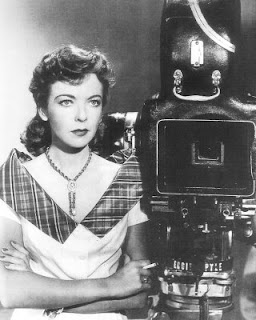By the time the 1940’s and 1950’s arrived women directors were virtually unheard of in Hollywood. Those women who had influenced the film industry from its inception, and who were in fact responsible for much of film’s initial popularity, had names no one mentioned, remembered or recognized. Ida Lupino’s name was known but as it appeared in front of the camera. She had been a successful actress for years, having given strong.
With performances in films like High Sierra and They Drive by Night. But in the late 1940’s, Lupino wanted more creative control over her projects. The opportunity for this was never going to happen unless she started her own production company. She did so, The Filmakers, with her then husband, Collier Young. The Filmakers shot their films on location with small budgets and tackled subjects Hollywood didn’t want to go near – taboos at the time and even now to some degree – unwed motherhood and bigamy were two. After producing two films with her new production company, Lupino began production on a new script she had written called Not Wanted. Director Elmer Clifton had a heart attack on the 3rd day of shooting and Lupino took over and directed the entire picture. She declined directorial credit on the film but it was her first endeavor as director. Ida Lupino would go on to direct six movies for The Filmakers from 1949 through 1953. No other woman could boast a similar accomplishment.
After four "woman's" films about social issues – including Outrage (1950), a film about rape – Lupino directed her first hard-paced, fast-moving film, The Hitch-Hiker (1953), making her the first woman to direct a film noir. Femmes fatales, sure — these stories could scarcely exist without them — but women behind the camera? To add a layer of irony on top of the unlikeliness, The Hitch-hiker does away with any trace of overt womanly presence. By the time we get to know the film’s hapless protagonists, a couple of buddies who look and act like fresh-cut slabs of all-American blandness, they’ve already told their wives they’re off to a fishing trip, and they’ll get back when they get back. Bearing straight south down the open road, no sooner do they reach Mexico than they pick up a hitchhiker. By the time they come to understand that this black-clad, lumpy-featured fellow has killed before, may well kill again, and intends to mount a ceaseless campaign of psychological manipulation in order to get a ride to his freedom, we understand why hitchhiking has gone out of style.
Lupino’s film doesn’t just remove the women from the noir formula; it leaves aside most of the darkness implicit in the genre’s very name. Apart from a few tense nighttime scenes and a climactic chase through an after-hours shipyard, the bulk of The Hitch-hiker‘s action takes place under a harsh Mexican sun that bleaches out nearly everything but the jagged shadows cast by unearthly rock formations along the empty road. Though actually shot on the eastern slopes of the Sierra Nevada mountains, the movie takes its foreign setting seriously, offering several relatively extended sequences and exchanges conducted entirely in untranslated Spanish. By the standards of midcentury American genre film, this nearly counts as an act of radical artistic experimentation. Yes, The Hitch-hiker plays a bit broadly today and leans on a few tropes that must have seemed creaky even in 1953, but it remains an unusual enough entry in noir history to merit attention — and not just because of the sex of the director.
Her films are all emotional, affecting, melodramas despite their measly budgets. The outcome of Lupino’s films always seems neutral where even the person doing wrong is not blamed for it in the end – no judgment. Her protagonists are ordinary people so her films did not feature the glamour Hollywood wanted and expected at that time. I expect it was either a result of the difficulty of getting funds in order to produce more movies, or perhaps the lack of funds in order to compete in marketing her films given the competition at the time, or simply a lack of interest in a small budget film directed by a woman, but Lupino’s directing of feature films did not last. In order to continue her directing she moved on to the small screen and directed many, many episodes of popular television shows. Ida Lupino continued to direct in television well into the 1970’s and I would say, became a pioneer in that medium as well...



Great post! Lupino certainly deserves more credit as a director as well as an actress. She also directed THE TROUBLE WITH ANGELS (1966), a very different film from the ones you mention here, but still worth watching, especially since it deals with a large cast of female characters.
ReplyDelete